

BOPPPS Model for Lesson Planning. TEC Variety eBook 5 4. Collaborative Learning Structures and Techniques. Three-step Interview Three-step interviews can be used as an ice breaker for team members to get to know one another or can be used to get to know concepts in depth, by assigning roles to students.
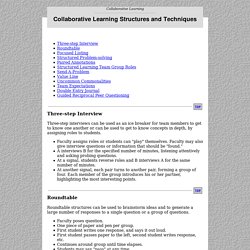
Faculty assigns roles or students can "play" themselves. Faculty may also give interview questions or information that should be "found. " A interviews B for the specified number of minutes, listening attentively and asking probing questions. At a signal, students reverse roles and B interviews A for the same number of minutes. Roundtable Roundtable structures can be used to brainstorm ideas and to generate a large number of responses to a single question or a group of questions.
Faculty poses question. The key here is the question or the problem you've asked the students to consider. The Phenomenon That’s Making PowerPoint Presentations Bearable (Even Enjoyable?) After death and taxes, the next unavoidable thing in life may be lousy Powerpoint presentations.

And for anyone who’s ever struggled to simultaneously read and listen as a speaker breezes through slides, Sean Smyth has some comforting words: It’s not your fault. The human brain simply isn’t equipped to multitask on that level. “Your mind can’t work that way,” says Smyth, the CEO of PechaKucha, a company that offers software and other services centered around a unique take on slide sharing. “It can’t both read and listen at the same time.” Scores of research studies back Smyth up, concluding that text plus speech simply equals too much new information to process. PechaKucha’s solution: Cut the copy—and keep it snappy. The company is something of an offshoot of an eponymous style of slideshare presentation that’s as fast-paced as its pronunciation (peh-CHA-keh-CHA, said quickly, with no break between the words). A standard PechaKucha, known as 20x20, is simple enough. Short and Sweet. Learning Activities and Active Learning Online: IU - Teaching Online.
In this module, we will look at learning activities that require students to actively "do something" with the content and concepts and reflect on the doing (individually or in pairs or groups).

By the end of this unit we hope that you will be able to identify learning activities with different types of interaction (student↔content, student↔faculty, and student↔student) and plan a mix of active learning activities leveraging different types of interaction to enhance your course. Pedagogical Strategy: Active Learning - Eberly Center. Active Learning Institute. Looking for ways to increase student engagement in your face-to-face or online classroom environments?

Our hands-on Active Learning Institute helps faculty transform their undergraduate and graduate-level courses into environments for participatory learning. This year’s Institute takes place Tuesday, June 18 – Thursday, June 20, 2019 from 9:00 AM to 4:00 PM in Butler Library 212. Who is the Active Learning Institute open to? The Active Learning Institute is open to all Columbia faculty interested in increasing active learning in their courses. Faculty members may invite the designated graduate teaching assistant(s) for the course they will be developing to attend the Institute with them. Activelearningcooksatherpdf.
Teaching with Technology. Active Learning?
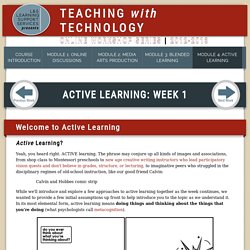
Yeah, you heard right. ACTIVE learning. The phrase may conjure up all kinds of images and associations, from shop class to Montessori preschools to new age creative writing instructors who lead participatory vision quests and don't believe in grades, structure, or lecturing, to imaginative peers who struggled in the disciplinary regimes of old-school instruction, like our good friend Calvin: Active Learning & Pedagogy Annotated Bibliography - Part 2. Teaching & Advising > Active Learning Active Learning & Pedagogy Annotated Bibliography - Part 2 Heffernan, Kerrissa (2001).
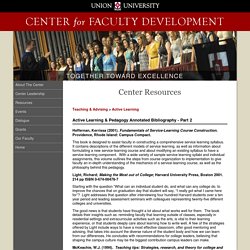
Fundamentals of Service-Learning Course Construction. Providence, Rhode Island: Campus Compact. This book is designed to assist faculty in constructing a comprehensive service learning syllabus. Light, Richard; Making the Most out of College; Harvard University Press, Boston 2001. 214 pp ISBN 0-674-00478-7 Starting with the question “What can an individual student do, and what can any college do, to improve the chances that on graduation day that student will say, “I really got what I came here for”?
The good news is that students have thought a lot about what works well for them. McKeachie, W.J. (1994). Teaching Tips was written to answer the questions posed by new college teachers, to place them at ease in the their jobs and to get them started effectively in the classroom. Menges, Robert, Maryellen Weimer & Associates. (1996). Meyers, C. & Jones, T.B. (1993). Active Learning & Pedagogy Annotated Bibliography - Part 1.
Scholarship and Professional Development > Annotated Bibliographies Active Learning & Pedagogy Annotated Bibliography - Part 1 Adams, Dennis & Mary Hamm. (1994).
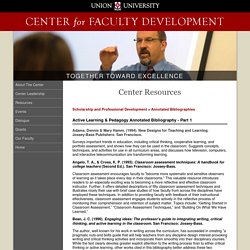
Center for Teaching & Learning. Active Learning Strategies help to initiate learners and instructors into effective ways to help everyone engage in activities based on ideas about how people learn. Multiple active learning strategies may be used in each of the active learning designs.
Review an annotated list of active learning strategies 1. Sit & talk with peers nearby Think-Pair- Share. 1. 2. 3. Listen to their responses.Ask students to elaborate on their thinking by providing explanations, evidence, or clarifications. Interactive lectures2. MIT Teaching and Learning Laboratory. Watch Active Learning in Action at MIT Guideline: Actively engage students in the learning process.
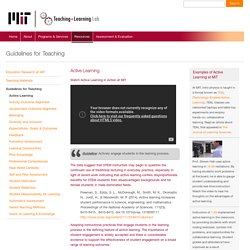
The data suggest that STEM instructors may begin to question the continued use of traditional lecturing in everyday practice, especially in light of recent work indicating that active learning confers disproportionate benefits for STEM students from disadvantaged backgrounds and for female students in male-dominated fields. Freeman, S., Eddy, S. L., McDonough, M., Smith, M. K., Okoroafor, N., Jordt, H., & Wenderoth, M. Center for Educational Innovation. Choose meaningful activities or questions Explain your rationale to students Develop a facilitation approach Gather and record feedback. Active learning larger classes. CEI CATs Matrix. Best Practices: Active Learning. Handout interactive techniques. FYC2. Activities to Boost Student Engagement. 14 Creative Ways to Engage Students – CELT. Fostering creativity can range from simple team-building exercises to complex, open-ended problems that may require a semester to solve.
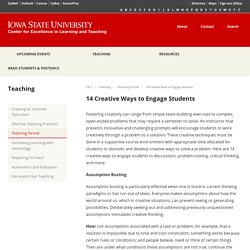
An instructor that presents innovative and challenging prompts will encourage students to work creatively through a problem to a solution. These creative techniques must be done in a supportive course environment with appropriate time allocated for students to discover and develop creative ways to solve a problem. Here are 14 creative ways to engage students in discussions, problem-solving, critical thinking, and more: Assumption Busting Assumption busting is particularly effective when one is stuck in current thinking paradigms or has run out of ideas. How: List assumptions associated with a task or problem, for example, that a solution is impossible due to time and cost constraints; something works because certain rules or conditions; and people believe, need or think of certain things. TEC Variety eBook 5 4. Instructional Strategies.